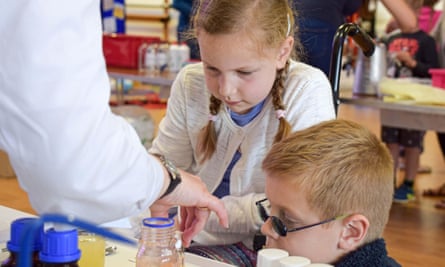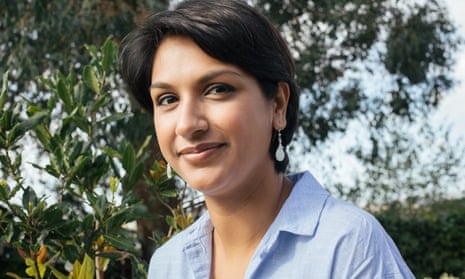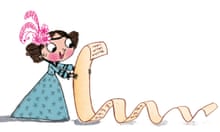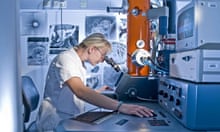When young men and women come up against sexist stereotypes masquerading as science, Angela Saini wants them to be armed with the facts. “I call my book ammunition,” she says of her 288-page prize-winning work Inferior: The True Power of Women and the Science that Shows It. “There are people out there who insist that somehow the inequalities we see in society are not just because of historic discrimination, but also because of biology – the idea that there are factors within us that will cause men or women to be better at some things than others.”
She wrote Inferior to demonstrate that “actually, science doesn’t support that point of view. I think it’s important we understand these scientific facts. We need that ammunition to counter the weird mistruths that are circulating within and outside science about sex difference”.
To female scientists fed up with being treated as though their brains are the odd exceptions among their sex, Inferior is more than just a book. It’s a battle cry – and right now, it is having a galvanising effect on its core fanbase. On 31 July a crowdfunding campaign to send a copy of Inferior to every mixed secondary school in England with more than 1,000 pupils was launched by Dr Jessica Wade, a British physicist who writes 270 Wikipedia pages a year to raise the profile of female scientists. Within two days the campaign had raised £2,000. Yesterday it reached its original £15,000 target and was powering its way towards £20,000 – a figure which would allow the book to be sent to every state school in the country.
“There’s nothing you want more than for people to be inspired by your work,” says Saini, 37, a multiple award-winning science journalist, who first became intrigued by sex difference research when she wrote about the menopause for the Observer. “What Jess is doing means such a lot to me. I hope if my book can empower her, it can empower other young women, and men, too.”
The key message she hopes her readers will take away is that nothing in science suggests equality is not possible. “We are not as different as the inequalities in our society makes us believe we are. Even now, there are people saying we shouldn’t be pushing for gender equality because we’re never going to see it for biological reasons.” For example, many people think there are large psychological differences in spatial awareness, mathematical reasoning or verbal skills between men and women. “Actually, those differences are tiny, a fraction of a standard deviation,” says Saini. “Psychologically, the differences between the sexes are not enough to account for the inequalities we see in our society today.”
Inferior is not a children’s book by any stretch of the imagination. It includes a firsthand account of female genital mutilation and deliberately examines a large number of academic studies in painstaking detail. But, like recent bestselling children’s books Goodnight Stories for Rebel Girls and Fantastically Great Women Who Changed the World, it could play a valuable role in breaking down gender stereotypes for the next generation of would-be scientists and mathematicians, and Saini is confident many teenagers will engage with it. “Girls and boys aged 13 or 14 upwards have really responded to the message, and the earlier we can get this message to them, the better.” She was the only girl in science and maths classes at school. “Even if it’s not overtly stated to you, just being in a minority – especially a minority of one – makes you think maybe there are some differences between the sexes.”
Researching and writing the book has totally changed how she feels about herself, destroying her own “subconscious stereotypes” about women. “It made me look at the world differently. That’s the power of science.”
In one of the most shocking chapters, Saini relays a letter written by Charles Darwin in which he argues that women are intellectually inferior to men. “He was looking at society. He saw women weren’t achieving as much and he treated us almost the way you would treat observations of lions or peacocks in the wild. He thought: this reflects the biological facts.”
Even at the time, contemporary female intellectuals pointed out that this theory ignored a lot of obvious historical and cultural factors, but Darwin failed to take on board their arguments. “It was quite lazy of him, which is surprising, because he wasn’t a lazy scientist. He was usually so painstaking and thorough.”

But she still admires him for everything he got right. “Even the best scientists can fall into this trap of looking at the world around them and thinking: things are the way they are because of nature.” After all, she points out, assuming 19th-century scientists could be biased but 21st-century scientists never are makes no sense. “That’s why, in the book, I look not just at the science, but at the scientists.”
These range from Kristen Hawkes, whose research suggesting postmenopausal women played a vital role in increasing the human lifespan has been met with dogged resistance from some male scientists, to Robert Trivers who, Saini shows, used evidence from a flawed 1948 experiment on fruit flies when he famously argued that men are more naturally promiscuous than women. “A lot of people – especially scientists – view science as perfectly objective and rational. But the questions researchers choose to ask, and the answers they come up with, are heavily affected by their prior assumptions.” At times, the book shows a staggering lack of respect from male scientists towards the work of their female contemporaries. “Science won’t improve unless we understand that we all have biases and those biases affect research,” says Saini.
Since it was published in 2017, her book has sold 20,000 copies, won Physics World Book of the Year and triggered a worldwide “STEMinist” book club movement among feminist scientists, technologists, engineers and mathematicians. Saini says she has even had positive feedback about it from James Damore, a Google software engineer who made headlines last year when he wrote an internal memo arguing biological differences were the reason behind the low number of women in tech. “We need scientific arguments to counter those politically motivated statements,” she says. “These arguments matter personally, in terms of how we think about ourselves, but also politically. We cannot afford to be complacent. There are movements around the world that are trying to take back the rights of women – rights our mothers and grandmothers fought so hard for. We can take anything for granted.”
Wade says the book gave her “all this power. You read it and you have evidence. You can debate it”. She set up the crowdfunding campaign because she suspected private girls’ schools would be buying it for their libraries, and wanted state school students to have the same access. “Reading this book when doing your GCSEs or A levels is the perfect time, because you’re making decisions that will impact your entire career. I want girls to recognise they can do anything.”
The actor Daniel Radcliffe, a childhood friend of Wade, is planning to release a video in support of the crowdfunding campaign this week. He describes Inferior as “a truly mind-blowing book”, which has made him completely reevaluate his understanding of the world.“As many people as possible should have access to this book, and I am certain Jessie – who has always been the smartest person I know – is going to make that happen,” he says.
Saini, a Londoner with Indian parentage, is working on her next book on the science of race. “Race science is more taboo, but the way prejudice plays out within the research illuminates similar issues as those of Inferior.”
Despite the sexism and racism she has documented in science, she feels positive about the future. “If we catch children early, we can achieve enormous change. I don’t think anyone is born with prejudices. I’m optimistic.” She points out that, historically, male scientists gained their power by excluding women from clubs, societies and institutes. “Now women are forming their own networks. And there’s no limit to what we can achieve.”
Sorting the facts
from the fiction
Myth: There is such a thing as a typical male brain and a typical female brain from birth
Fact: Research has found that only the tiniest gaps, if any, exist between boys’ and girls’ fine motor skills, ability to perform mental rotations, spatial visualisation, mathematical ability, verbal fluency and vocabulary. Under normal conditions, large gaps between boys and girls haven’t been found by scientists studying the typical development of babies. In fact, the overlap between the sexes is so huge that scientists have struggled to find and replicate results that suggest there is any real gap at all.
Myth: Men are better at carrying out a single task, while women are better at multitasking
Fact: In 2013 this claim was put forward in a press release summarising an important study by the scientist Ruben Gur on the brain wiring differences between the sexes, but was not detailed in the study itself. In conversations with Saini documented in Inferior, Gur said he hadn’t seen any scientific evidence to support this claim, and he’s not sure how it made it into the press release.
Myth: Women are naturally less intelligent than men because their brains are smaller and lighter
Fact: Men do, on average, have slightly bigger heads and slightly bigger brains than women. But as the trailblazing intellectual Helen Hamilton Gardener pointed out in the 19th century, it is the ratio of body size to brain size that is important. Otherwise, as she put it, “an elephant would be able to out-think all of us”.










